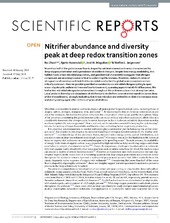Nitrifier abundance and diversity peak at deep redox transition zones
Peer reviewed, Journal article
Published version

Åpne
Permanent lenke
http://hdl.handle.net/1956/20476Utgivelsesdato
2019-06-14Metadata
Vis full innførselSamlinger
Originalversjon
https://doi.org/10.1038/s41598-019-44585-6Sammendrag
More than half of the global ocean floor is draped by nutrient-starved sediments characterized by deep oxygen penetration and a prevalence of oxidized nitrogen. Despite low energy availability, this habitat hosts a vast microbial population, and geochemical characteristics suggest that nitrogen compounds are an energy source critical to sustaining this biomass. However, metabolic rates of nitrogen transformation and their link to microbial survival in this global-scale ecosystem remain virtually unknown. Here we provide quantitative constraints on microbial nitrogen cycling in open ocean oligotrophic sediments from seafloor to basement, spanning approximately 8 million years. We find active microbial nitrogen transformation throughout the sediment column but at very low rates. Local peaks in diversity and abundance of nitrifiers and denitrifiers occur at redox transition zones deep within the sediments, strongly indicating that these microbes are revived from their maintenance state and start growing again after millions of years of attrition.
